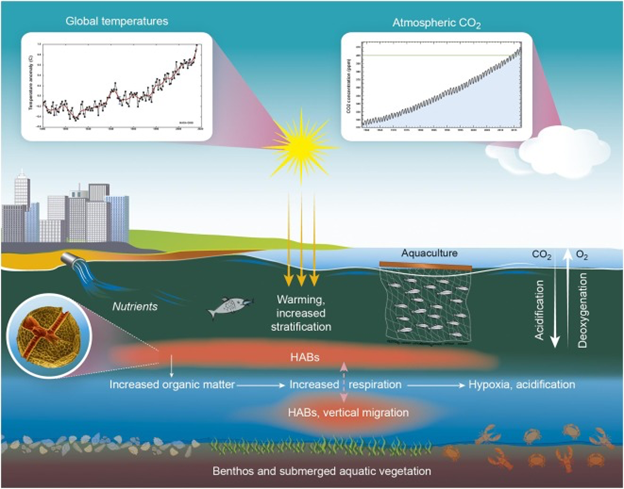NOAA’s National Centers for Coastal Ocean Science Competitive Research Program and Ocean Acidification Program are pleased to announce a new 2022 Notice of Funding Opportunity (NOFO) for projects that address the growing need to understand interactions between ocean acidification (OA) and harmful algal blooms (HABs) and their cascading impacts on coastal ecosystems, communities, and economies to inform management decisions.
There is growing concern regarding HAB and OA co-occurrence and impacts. Both HABs and OA are threats to marine ecosystems and human communities in the coastal zone. While research to date has provided insights into the many factors that regulate HAB dynamics, toxicity, and impacts, only a few of these have included OA. Similarly, OA studies have examined ocean biogeochemistry and impacts to marine resources and economies and have started to expand into multi-stressor research studies (e.g., with hypoxia and warming). Recent studies indicate that increased carbon dioxide concentrations support higher phytoplankton densities and that OA parameters have variable effects on growth rate and cellular toxin production in different HAB species and strains.

OA and HABs can impact the same coastal resources (e.g., aquaculture, wild fisheries, and tourism) in different ways and there may be synergistic or antagonistic effects that are not recognized by current research efforts. OA and HABs have some common drivers in coastal areas and often co-occur in space and time, which will likely become more common in the future.
NOAA is soliciting proposals to address the science needs identified in the Ocean Acidification and Harmful Algal Blooms: Defining a Research Agenda virtual workshop held in August 2020 (report). NOAA expects to fund 3 to 5 projects for up to three years in duration. Proposals should not exceed $1.5 million in total.
A letter of intent is required. The deadline for letters of intent is October 14, 2021, and full applications are due January 19, 2022. View the full NOFO here.
NCCOS hosted an overview and Q&A webinar for potential applicants on September 7, 2021 (a webinar recording, PowerPoint slides, and Q&A are available).

